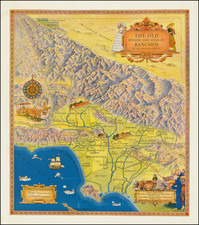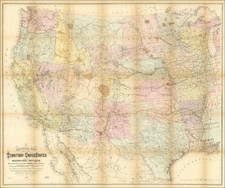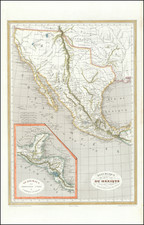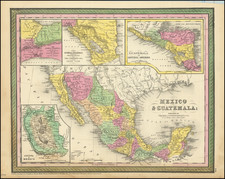Extraordinary variant edition of George H. Baker's early view of the important western outpost of Fort Yuma on the Colorado River.
George Baker's view of Fort Yuma is one of the most mysterious and fascinating California views. The view exists in two known editions. One view, signed by Baker and entitled "Fort Yuma, Colorado River, California," shows a relatively normal and orderly view of the river crossing at Fort Yuma. The second, which is unsigned but attributed to Baker (the present view), provides a much more raw and realistic view of this outpost on the road to California.
Baker's view provides a unique insight into the life of Fort Yuma, a critical nexus of transport, commerce and military operations in the American southwest. Taken from the eastern, or Arizona side of Colorado River, the view looks across to Fort Yuma, perched on a bluff overlooking the river (on the California side). The western bank is shown to be a model of order in an otherwise wild land. The fort's imposing succession of stockades, surmounted by the stars and stripes, overlooks a caravan of covered wagons, while a cable-led ferry prepares to traverse the river from the opposite bank. Docked at the crossing, is a flat-bottomed river steamer, billowing smoke, which unloads provisions brought up the river by way of the Sea of Cortes.
In sharp contract to the neat depiction of the California side, the foreground of the present view hosts a frontier scene that is unusually candid in content, albeit somewhat stylized. Horseman and covered wagons are shown to gather in preparation for the ferry crossing. Abutting the ferry wharf are two cannons, supposedly detritus of the recent U.S. Civil War. Quite interestingly, however (and unlike the signed edition of Baker's view), by the porch of the saloon, which is surmounted by the sign labeled 'Wine & Liquors', three men are humorously shown to stagger in an intoxicated stupor. To the left of the foreground, gather a party of bare-chested Yuman Indians, apparently gathering to trade for goods with the recently arrived Americans. The inebriated state of the saloon revelers and the attire of the Native Americans is highly unusual in the contemporary genre of lithographic views of the American West, which generally sought to sanitize or 'edit out' such candid scenes in order to aspire to an ethic of picturesque idealism. While such scenes of drunkenness and the like were daily aspects of western life, their inclusion in prints risked offending Victorian society, and thus would not normally be included in a print intended for a commercial audience.
In this vein, it seems that the present lithograph, done with charmingly crude technical execution, may have been intended to be a humorous piece, produced in very limited quantity, and not destined for broader circulation. In Baker's "signed" version, the Yuman Indians are shown fully clothed and appear in a more orderly disposition. Moreover, the saloon is alternatively shown to be a 'Market', where its orderly patrons assume stoic poses, in sharp contrast to the drunken revelry of the saloon patrons. One can speculate that Baker after visiting Yuma or obtaining a sketch from someone else, hastily lithographed the present work as an entertaining 'maquette' in preparation for his formalized work intended for commercial circulation. Given Fort Yuma's great importance during the mid-nineteenth century, it is surprising that the only recorded contemporary prints of the subject are the two versions of Baker's lithographs.
The precise dating of the present print is difficult to establish. The view has been dated as early as circa 1850 by one writer, while Reps dates it to be from circa 1875, while the presence of the cannon suggests that it was made after the U.S. Civil War (1861-5), but before the arrival of the railroad which supplanted the ferry in 1877.
Fort Yuma was one of the most important outposts in the American southwest. Perched upon a highland on the western bank of the Colorado River (in modern Imperial County, California) it guarded the most important crossing point of the lower part of the river. The location played important roles in the early Spanish exploration of the southwest, various conflicts with the Native Americans, the Mexican-American War, the U.S. Civil War and the development of the overland transport routes that connected California to the rest of America. For centuries the location was valued by Native Americans as the only natural crossing of the Colorado River near the mouth of the Gila River, and was thus the nexus of several major overland trails. Its proximity to the river's estuary permitted direct access by boat to the Sea of Cortes.
In 1774, it was used as a strategic victualing point during the legendary Second Anza Expedition, which successfully opened an overland route between New Mexico and the missions of southern California, and beyond that San Francisco Bay. In 1779, Padre Francisco Garces founded a mission near the future site of the fort. While the Spaniards added a presidio to guard the mission, it was soon destroyed by the unwelcoming Yuman Indians. Indeed, the effective resistance the Yumans, the Mojaves and the Apaches inhibited further development for some decades.
During the Mexican-American War (1845-8) the Yuma Crossing began to play a critical role in the history of the American southwest. It was traversed by General Stephen Kearny's Army of the West en route to California in 1846, and the following year by Lt. Colonel Philip St. George Cooke's storied Mormon Battalion. Upon the advent of the California Gold Rush in 1848, the Yuma Crossing was inundated with prospectors and immigrants travelling on horseback and in covered wagons along the southern Transcontinental Trail. The ferry business boomed, most notably led by the company founded by Louis J. F. Jaeger. In October 1849, on a small bluff on the west bank of the river, Lieutenant Cave J. Couts, who was working as a member of Whipple's party of topographical engineers surveying the U.S.-Mexican boundary, established Camp Calhoun. However, this position was soon abandoned in the face of Native attacks during the so-called 'Yuma War'.
In March 1851, the post was reestablished on the same site with a larger garrison and heftier ordinance, and quickly consolidated its role as a commercial center and customs office. Steamboat service running down the river to the Sea of Cortes soon followed. From 1858-61, it was one of the main stages on the famed Butterfield Overland Mail route. Across the river sprang the settlement of Colorado City (later modern Yuma, Arizona), and as depicted in the present lithograph, it became a bustling and garrulous locus of commerce and exchange. During the U.S. Civil War, Fort Yuma remained in Union hands, and played a vital role in preventing Confederate scouts form entering California, for the eastern bank of the river was for a time nominally part of the secessionist Territory of Arizona.
Following the war, Fort Yuma guarded the important Yuma Quartermaster Depot on the Arizona side of the river. The completion of the Southern Pacific Railroad in 1877, which ran through Yuma, negated the crossing's role as staging area, diminishing the fort's usefulness. Fort Yuma was decommissioned in 1883, although the town on the opposite side of the river would continue to function as an important regional center, a role it enjoys to this day. Presently, the site of the fort is occupied by the Fort Yuma Indian School and the Saint Thomas Yuma Indian Mission, while the Yuma Crossing is a registered National Heritage Area.
George Holbrook Baker (1827-1906) was an important lithographer of Western American scenes. Born in Massachusetts, he was educated at the National Academy of Design, before heading to California during the Gold Rush. He settled in Sacramento and published several important views of that city. After moving to San Francisco in 1862, he notably produced an important view of San Diego as well as the aforementioned views of Fort Yuma.
The present lithograph is exceedingly rare. Reps locates the copy in the Library of the Society of California Pioneers, The M.H. de Young Memorial Museum of Art (San Francisco), and the Chicago Historical Society.














